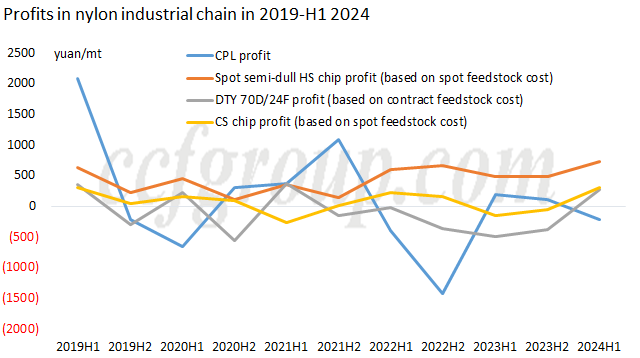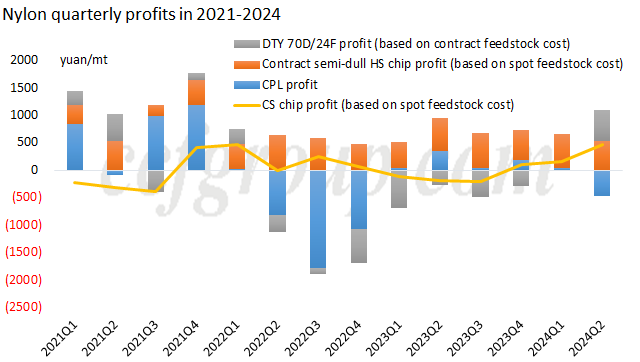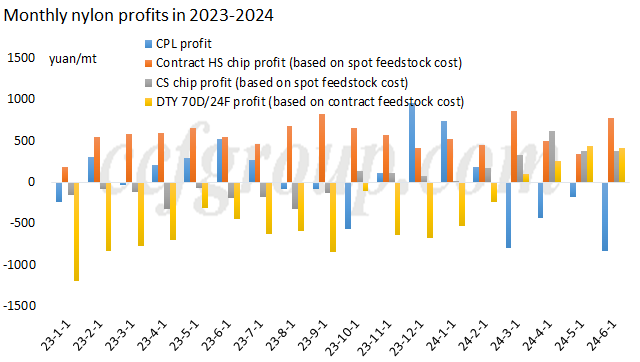Profits redistributed in nylon industrial chain in H1 2024
Looking back at the first half of 2024, profits in various segments of nylon industry have been mixed, with both sweet and sorrow.
1. In H1 2024, CPL profits gradually shifted downstream

In the first half of this year, profits in the nylon industry primarily shifted from upstream CPL to downstream chip and textile filament.
Due to the addition of 400kt/year of new CPL capacity in the first half, slightly higher than the 373kt/year of new nylon 6 capacity, and with the average operating rate of CPL plants reaching as high as 94%, the supply increase has been more pronounced compared to the second half of 2023. Consequently, CPL supply side has not been tight overall. Particularly, after the new facility of Hunan Petrochemical was commissioned, the sensitivity of spot prices to fluctuations increased, and the bargaining power gradually shifted towards the buyer's market, leading to a significant compression in CPL profit margins.
In contrast, new capacity for CS chip in the first half of the year was not many, and demand for film and modified plastics showed some recovery compared to last year, improving the supply-demand structure, resulting in a gradual improvement in CS chip profits, making it one of the better periods in recent years. Since HS chip is primarily traded through contracts, and there were periods of tighter supply for semi-dull HS chip in the first half of 2024, along with an expansion of operational space for CPL spot trading, profits increased further compared to the second half of last year.
Nylon 6 textile filament market maintained a growth momentum in demand, with little new capacity added in the first half of the year, leading to supply shortages for several specifications that required order backlogs. Profits significantly increased compared to the second half of last year. Even for the most conventional semi-dull DTY 70D/24F, the profit calculated on a full-cost basis turned from a loss to a profit, and many other specifications performed even better.
2. Evident profit changes in Q2 2024

On a quarterly basis, the overall industry profit in the first quarter of 2024 showed slight improvement compared to the fourth quarter of 2023, with filament moving from a loss to profit, CPL profits slightly compressed, and chip profits remaining relatively stable compared to the fourth quarter of last year.
In the second quarter of 2024, a clear divergence emerged, as CPL profits were significantly compressed following the start-up of 300kt/year new capacity; in contrast, CS chip and filament profits showed marked improvement supported by demand, particularly with filament profits expanding significantly. HS chip profits remained stable due to a relatively balanced supply and demand, while semi-dull HS chip profits were consistently robust. However, dull HS chip suffered from over-supply, resulting in occasional losses for some sources to facilitate transactions.
3. Monthly profits show stability only in HS chip, with declines in others to varying degrees

On a monthly basis, CPL profits saw a substantial decline in March. Although there was a slight recovery in April and May, markets plunged in June due to a combination of declining benzene prices and weakening demand, leading to a general bearish sentiment and further compression of processing margins. (It should be noted that in the first half of this year, CPL manufacturers generally operated at full capacity or even exceeded operational rates, resulting in lower actual costs and narrowed losses compared to the chart above, which serves only as a reference trend.)
CS chip profits steadily rose from January to April but slightly contracted in May and June due to a slight weakening of demand, along with cautious buying driven by falling raw material prices, leading to a temporary decline in transaction volume. Profits for HS chip, mainly traded through contracts with a smaller proportion of spot trade, maintained a stable preference range. In June, when CPL spot prices showed marked declines, HS chip profits expanded.
Nylon textile filament profits showed a month-on-month recovery starting from the beginning of the year, reaching a peak in May, supported by strong demand. However, with a seasonal decline in demand in June and ongoing drops in raw material prices, filament manufacturers gradually built up inventory, and during this decline, profit margins were appropriately compressed.
Summary and outlook:
(1) CPL profits were notably compressed in the first half of the year, and it will be challenging to continue compressing profits at the foundation established in June. With new polymer production ramping up in the second half of 2024, profits may be restored to some extent.
(2) HS chip profits are the most stable, but with plans to increase capacity by nearly one million tons from August to December, competition will intensify, leading to profit compression.
(3) Nylon textile filament profits were good in the first half of the year, but since June, due to weakening demand, profits have also slightly compressed. Looking ahead, given that new DTY capacity is limited, it is expected that high-end products can still maintain relatively good processing fees. However, with a significant increase in new FDY capacity, profits are expected to decline overall.
- Top keywords
- Cotton Price
- Cotton Futures Price
- Cotton Futures
- CZCE
- PTA Futures Price
- Chemical Fiber
- Polyester Prices
- Wool price
- PTA Futures
- Shengze Silk
- China
- Yarn Price
- price
- China Textile City
- Fibre Price
- Benzene Price
- Cotton
- Index
- Cotton Index
- PTA
- fabric price
- NYMEX
- Top 10
- textile industry
- Spot Cotton
- Cotton Yarn
- Polyester Price
- Futures
- PTA Price
- cotton yarn price

